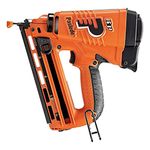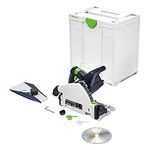Belt sanders reviewed
Choosing the right belt sander depends on your needs
Bosch 1274DVS

(877) 267-2499
www.boschtools.com
Configuration: In-line
Amps: 6.6
Variable speed: Yes; 550 fpm-1100 fpm
Cord: 6 ft., 18/2
Noise level: 104 db.
Dust collection: Side-mounted bag
Weight: 7.1 lb.
Street price: $169.95
Sanding frame available: Yes
The Bosch’s graphite-coated platen is the only dead-flat platen in this survey. The 1274DVS lies flat on its top and side. This makes it easy to clamp the sander to the bench for use as an edge or stationary sander. The trigger-mounted variable-speed control works so well that it’s hard to understand why all the variable-speed sanders aren’t set up like the Bosch. The belt-tracking control is smooth.
On the downside, the tool could use more power and a longer cord. The belt-release lever is a frail-looking plastic. Moreover, this lever works stiffly, so releasing the belt takes a lot of pressure. This combination worries me.
The dust bag is made of fairly delicate cloth, but it picks up most dust. However, the dust bag is so small that it fills up after just a few minutes of sanding.
As in other in-line machines, the Bosch’s handles are too far apart for me. The front handle is removable, letting you sand close to the front of the tool in tight quarters.
DeWalt DW 430 and DW 431VS

(800) 433-9258
www.dewalt.com
Configuration: Transverse
Amps: 5.2
Variable speed: DW 430, yes; 475 fpm-1100 fpm
DW 431VS, no; 1100 fpm
Cord: 9 ft., 18/2
Noise level: 92 db.
Dust collection: Yes
Weight: 6.2 lb.
Street price: DW 430, $187.50; DW 431VS, $188
Sanding frame available: Yes
The only apparent difference between these sanders is the variable-speed feature. The front cowling comes off, exposing the entire front wheel and about 2 in. of the belt. This feature alone is almost worth the purchase price because it lets you sand into rounded inside corners and other tight places with ease. However, when you remove this cowling, you also remove the dust-collection system.
The dust-collection system works great and is easy to remove and empty. These sanders are the most compact of all surveyed, and they have the best, most-informative manuals. The metal platens are flat enough to be useful, the belt tracks and releases smoothly, and the cord is a respectable length.
The knob and the handle are 3 in. apart, too close to give me good control. There isn’t enough power, especially at low speeds. The dust bag is constantly in the way. Reaching the variable-speed dial in the handle is awkward.
Hitachi SB-75

(800) 706-7337
www.hitachi.com
Configuration: Transverse
Amps: 8.7
Variable speed: Dual; 1180 and 1475 fpm
Cord: 8 ft., 18/2
Noise level: 102 db.
Dust collection: Yes
Weight: 10.8 lb.
Street price: $169
Sanding frame available: No
The other sanders could use this much power. The Hitachi had the most power of all the sanders. The handle spacing seemed just about right, and the sander was comfortable to use. The belt tracking worked well. The Hitachi picked up most of its dust, and the bag was easy to remove and empty.
The Hitachi has a 4-in. wide platen. The idea is that you can track the belt over to the side to sand flush with a vertical surface. All the other sanders except the Makita have 3-in. platens, and they sand flush anyway. The advantage of this 4-in. platen is lost on me. I find that the extra width makes the sander more difficult to handle. The platen was so convex that it was hard to keep track of what exactly I was sanding. I had to stop the sander to change speeds. The belt-release lever was extremely stiff. The lever was metal but so small that changing belts was painful.
Makita 9900B

(800) 462-5482
www.makita.com
Configuration: Transverse
Amps: 7.8
Variable speed: No; 1180 fpm
Cord: 16 ft., 18/2
Noise level: 98 db.
Dust collection: Yes
Weight: 10.1 lb.
Street price: $179
Sanding frame available: No
My favorite feature of this machine has to be the 16-ft. cord. I would rarely, if ever, need an extension cord with this machine. Next, the 9900B’s raw power is impressive. Dust collection is first rate; nearly every particle was picked up. The tracking control and overall operation are smooth. Its platen is the flattest metal platen surveyed, and the belt-release mechanism works well.
The 9900B also has a 4-in. wide platen. The 4-in. wide platen makes this machine wider than need be and puts it out of balance. Removing and replacing the dust bag is difficult.
Makita 9901

(800) 462-5482
www.makita.com
Configuration: Transverse
Amps: 6.7
Variable speed: No; 1246 fpm
Cord: 6-1/2 ft., 18/2
Noise level: 95 db.
Dust collection: Yes
Weight: 7.7 lb.
Street price: $169
Sanding frame available: Yes
This sander lies flat on its side, and is lightweight and fairly quiet. Dust collection works well. The platen is as flat as most of the metal platens, meaning not very. The belt-release mechanism and tracking control work fine.
Even though the 9901 costs nearly as much as the 9900B, I found it a difficult sander to like. The rear roller of the machine I used was 0.035 in. out of round. That means it has a lump in it the thickness of 15 pages of this magazine, or the width of a sparkplug gap. This deformed roller causes surging and vibration, leaving streaks in the sanded surface. The front roller was plastic, not metal as on all the other sanders, but at least it was round. The 9901 is underpowered, ad its cord length is marginal.
Porter-Cable 351

(800) 487-8665
www.porter-cable.com
Configuration: Transverse
Amps: 7.0
Variable speed: No; 1300 fpm
Cord: 7 ft., 18/3
Noise level: 98 db.
Dust collection: None
Weight: 10 lb.
Street price: $168
Sanding frame available: No
The 351 is a basic sander with plenty of power and a nice businesslike look and feel. It is the most comfortable to use of all the sanders I surveyed. The handles are in just the right spots. The belt-release lever is sturdy metal and operates smoothly.
It wasn’t perfect, though. The platen is metal and was notably convex. I prefer having a dust bag on a belt sander, and the 351 is the only sander in the survey without one. Finally, the tracking control is somewhat coarse, meaning that a small movement of the adjusting knob results in a large movement of the belt.
Porter-Cable 352VS

(800) 487-8665
www.porter-cable.com
Configuration: Transverse
Amps: 7.0
Variable speed: Yes; 850 fpm-1300 fpm
Cord: 7 ft., 18/3
Noise level: 99 db.
Dust collection: Yes
Weight: 10.75 lb.
Street price: $169
Sanding frame available: No
The 352VS is almost identical to the 351, except with variable speed and a dust bag. Like its sibling, the 352VS looks and feels great. The 352VS operates smoothly, with plenty of power, even at low speeds. The dust-collection system is effective. The dust bag is easily removed and holds a lot of waste. The belt releases with no trouble.
As much as I like this sander, it has problems. I managed to put a hole in the thin cloth of the dust bag just hauling it in my truck. The metal platen isn’t flat. The variable-speed dial is especially tantalizing, clearly visible but just beyond my thumb’s reach. I find the speed awkward to adjust because I have to take my left hand off the front knob to do so. Like the 351, the tracking on the 352VS could be smoother.
Ryobi BE-321

(800) 525-2579
www.ryobi.com
Configuration: In-line
Amps: 6
Variable speed: Yes; 775 fpm-1148 fpm
Cord: 6 ft., 18/2
Noise level: 102 db.
Dust collection: Yes
Weight: 9 lb.
Street price: $140
Sanding frame available: Yes
The location of the variable-speed dial in the handle is convenient. I can easily change speeds without any loss of control. Because the sander lies flat on its side and on its top, it’s easy to clamp to a bench. This is convenient for sanding small hand-held parts. The Ryobi has good power and good belt tracking. The dust bag is mounted on the left of the sander and picks up dust well.
But this is another sander with a plastic belt-release lever. Considerable pressure is needed to release the belt, so it seems inevitable that the thin shank on this handle will break. The dust bag is quite small and needs frequent emptying, and the cord is short. The metal platen is convex and, unlike other sanders in this survey, lacks a cork backing.
Sears Craftsman 27725

(800) 377-7414
http://sears.com
Configuration: In-line
Amps: 6
Variable speed: Yes; 775 fpm-1150 fpm
Cord: 9-1/2 ft., 18/2
Noise level: 100 db.
Dust collection: Yes
Weight: 9 lb.
Street price: $130
Sanding frame available: No
The Ryobi and the Craftsman appear to be the same machine. However, neither Sears nor Ryobi would confirm this. A Ryobi spokesman did say that they make some power tools for Sears and that those tools are made to Sears’s specifications. Color, country of origin and cord length were the main differences I found. The longer cord on the Craftsman is handy, and as with the Ryobi, dust collection works well. There’s plenty of power. The variable-speed dial is conveniently located, and the sander lies flat on its side and on its top.
The Craftsman also has a plastic belt-release handle. Because of the considerable pressure needed to release the belt, I think that the lever will inevitably break. On all the in-line sanders, I found the handles to be too far apart for comfort. The lack of a cork cushion under the platen makes for uneven sanding. The dust bag is quite small and needs frequent emptying
Fine Homebuilding Recommended Products
Fine Homebuilding receives a commission for items purchased through links on this site, including Amazon Associates and other affiliate advertising programs.

Paslode Cordless Finish Nailer (IM250A)

Festool Cordless Track Saw (TSC 55 KeB-F)

Milwaukee Cordless Tablesaw (2736)

























